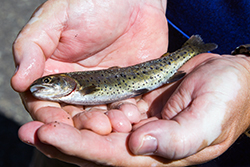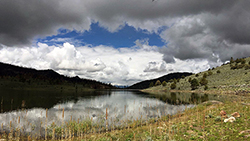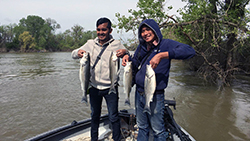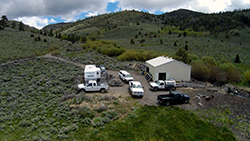



For generations, anglers in California’s eastern Sierra Nevada mountains fished for one of the most cherished fish in the west, the Lahontan cutthroat trout (LCT). These native beauties are prized for their size, with some growing as large as 40 pounds in the Tahoe Basin.
Sightings of these brown and red native fish have been documented as far back as 1853. But as the population of the state grew, especially during the Gold Rush, the fish were nearly wiped out by mining, development, dams, water diversion and other human factors.
Today, LCT are listed under both the State and Federal Endangered Species Acts, and CDFW has increased its commitment to angling enthusiasts by providing more opportunity to catch this historic fish. This effort includes greatly expanding the number of waters and fish planted in recent years.
Every spring, staff from the American River Hatchery in Gold River make the 100-mile journey from the hatchery to the tiny spawning buildings on the shore of Heenan Lake. This pristine body of water is surrounded by granite peaks in remote Alpine County. It is usually not accessible in the winter, cut off by the snowpack, and is only open to catch and release fishing for six weeks a year. It is also the state’s only source of LCT broodstock (groups of mature fish used as the source for eggs and reproduction). Ultimately, the 800,000 eggs spawned at Heenan Lake each year support recreational angling opportunities at multiple locations in the eastern Sierras.
The staff will make the journey up and down the mountain several times over several weeks to spawn the eggs on site. The process involves carefully bathing the eggs in iodine and suspending them in cheesecloth in aluminum jars about two feet tall, before making the journey back to Sacramento or to other state hatcheries. Some of the eggs head to destinations as far away as Filmore Hatchery in Ventura County.
Once at the hatcheries, the eggs are placed in “hatching jars,” where chilled, UV-filtered river water circulates over them continuously. After two to three weeks, the eyes of the baby fish are visible inside the eggs. These “eyed” eggs will be addled—a process in which the eggs are siphoned through a tube in order to shake them up. This causes the infertile, diseased or dead eggs to turn white, allowing hatchery technicians to easily identify, pick out and discard them. After the fry hatch, they are moved to deep tanks in the hatchery building, where they will spend approximately five months growing before being moved outdoors to large round tanks.
The fish will be planted as fingerlings or sub-catchables (fish that weigh 1/16th-1/6th of a pound) into various high-mountain waterways on the east side of the Sierras. At the time of release, they are still too small to be caught, but they will quickly grow to be trophy-sized fish for the state’s anglers who want to make the journey into the high altitudes.